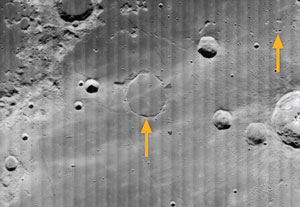Lunar volcanoes rock long-age timeframe

Evolutionary timeframes date the moon at about 4.5 billion years, with the lunar volcanism that produced the large, prominent and nearly circular, dark “seas” (or maria, as they are called) starting soon after that. The volcanism is mooted to have ended about three billion years ago.
But researchers studying recent images of the far side of the moon, taken from the Japanese SELENE (Kaguya) lunar satellite, report dark “seas” of volcanic rock they say are “only” 2.5 billion years old, “much younger” than formerly presumed.1,2 That’s because there are fewer craters (blasted by meteors) on the smooth dark surfaces than expected—assuming the rate of cratering has been constant through time. Fewer craters means that the volcanic lava flows can’t be so old.
Given this volcanic activity lasted (supposedly) 500 million years later than previously thought, evolutionists now have the challenge of explaining how lunar volcanism was able to persist for so long. The moon is only about one-quarter the diameter of Earth, and only about one-eightieth of its mass, so it should have long ago cooled, and long been geologically dead.
Peeling back the uniformitarian assumptions, as our knowledge of space increases, mounting evidence points to the solar system (and the rest of the universe beyond) being much younger than the presumed evolutionary ages, consistent with the biblical time-frame of only around 6,000 years.3
Ghost craters are young too

Ghost craters on the lunar maria also testify that that the moon is young.1
We have seen how each mare formed after a huge space object smashed into the moon blasting an enormous depression, cracking the crust and releasing molten lava from inside.
Ghost craters appear as faint circular shapes on the smooth maria (arrowed in figure) because their edges poke up from beneath the lava. They were formed by meteors and are visible because they are only partially filled with lava. By way of contrast, the small craters that formed after the maria solidified are sharp and clear.
Many ghost craters have been recognized and herein lies a dilemma for evolutionists. Based on the present slow rate of cratering, evolutionary astronomers need lots of time for the ghost craters to accumulate before they were filled with lava—500 million years in fact.
But, after the huge crust-cracking impacts, how much time would it take for the lava to flow from inside the moon and fill the maria basins? Obviously not long—a few hours, or days or weeks at the most. Longer than that and the lava would solidify and stop flowing. Such huge impacts would have had an effect immediately.
Thus, ghost craters reflect the catastrophic history of the moon, and are evidence for its youth. They also indicate that the rate of cratering was much higher at a certain time in the past. And the ages of the other planets and moons in our solar system, based on cratering counts, are also much younger than claimed. Creationist astronomers suggest this period of intense cratering coincided with the global Flood catastrophe that took place on Earth (Genesis 7:11–12).2
References and notes
- Fryman, H., Ghost craters in the sky, Creation Matters 4(1):6, 1999; creationresearch.org/creation_matters/pdf/1999/cm0401.pdf; see also Psarris, S, What you aren’t being told about astronomy, vol. 1: Our created Solar System, DVD, creationastronomy.com, 2009.
- Faulkner, D., A biblically-based cratering theory, Journal of Creation 13(1):100–104, 1999, creation.com/cratering; Spencer, W.R., Response to Faulkner’s ‘biblically-based cratering theory’, Journal of Creation 14(1):46–49, 2000, creation.com/crateringresponse. They propose that a brief, narrow swarm of space objects impacted the moon producing the distinctive, dark maria. This explains why the maria are almost exclusively confined to one side—the swarm passed before the moon had time to turn on its axis and expose the other side.
Re-posted on homepage: 22 July 2020
References
- Haruyama, J. et al., Long-lived volcanism on the lunar farside revealed by SELENE terrain camera, Science, doi: 10.1126/science.1163382, 6 November 2008. Return to text.
- Minard, A., Volcanoes rocked dark side of the moon, National Geographic News, news.nationalgeographic.com/news/2008/11/081106-moon-volcanoes.html, 6 November 2008. Return to text.
- See also Sarfati, J., The moon: the light that rules the night, Creation 20(4):36–39, 1998; creation.com/moon. Return to text.


Readers’ comments
Comments are automatically closed 14 days after publication.